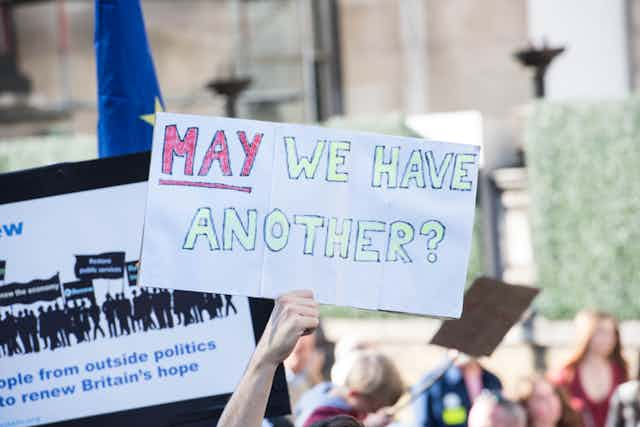Now that EU leaders have signed off the Brexit Withdrawal Agreement, Theresa May faces a huge struggle to get parliament’s approval for it. At a time where the country never seemed so divided, the prime minister managed to unite most MPs against her plans. Westminster is at a stand-off. The revolt is growing from all sides the longer it continues, ahead of a vote in mid-December.
If parliament’s Brexit deadlock continues, the public should now decide whether to accept May’s deal or remain in the European Union. But a second referendum must be treated with great care. Divisions over Brexit and mutual suspicions are high. Any such decision must command confidence from all sides if only to ensure finality in the result.
As someone who advised the Electoral Commission on the original referendum, which led to a change in the question’s wording and options, I knew how to make it fair, neutral and unbiased. A second referendum can, and must, meet that same test.
More than 17m people voted to leave the EU, but without a clear manifesto about what would happen if the UK did. This is in stark contrast to the referendum about Scotland’s independence and the then-Scottish government’s Scotland’s Future white paper which set out the terms for any such win. No similar clarity on policies were available for Brexit. This contributed to different understandings of what an acceptable Brexit should look like – and the ongoing divisions on which plan best captures the public mood.
With no parliamentary majority in sight, May has taken to the airwaves to make her case directly to the public. This is the right direction of travel: where MPs remain divided, a final say should be left with voters.
Referendum options
If parliament does approve May’s deal, then it will be the plan for Brexit which will govern what happens after March 29, 2019. But if parliament cannot accept it – which seems increasingly likely – then May should put her Brexit deal before the public in a new referendum. And the public should be asked to vote on two options: whether they want the only Brexit deal on the table, or whether they want the UK to stay in the EU.
Like the 2016 referendum, a new plebiscite would be legally advisory, meaning parliament would not be obliged to act on the result; but it would place parliament under considerable pressure to honour the result. Crucially, a second referendum must not be a re-run of the last one or open a Pandora’s Box of continued indecision.
This means a second referendum ballot should not include an option to reopen EU negotiations. Everyone from May to German Chancellor Angela Merkel has made clear that the current deal is the only deal available. Short of a snap elections, there is no clear mandate for starting afresh, nor is there time to do so now. If a referendum included an option of reopening negotiations, it would set up a cycle of more future referendums until the government likes the answer. That would not bring finality or respect democracy.

No Deal not on the ballot
Some argue that a second referendum would disrespect the 2016 result. But this is untrue. The country voted for Leave, but without a plan for how. Now there is a plan that requires parliamentary support – which it does not appear to have. A second referendum on the terms agreed with the EU would give the public a chance to either reaffirm its choice for Leave and so push parliament to move forward. Or not.
Nor should an option for a No Deal be on a second referendum ballot. No Deal was never really an option – and politicians on both sides of the aisle have said parliament will work to prevent a no deal.
If No Deal was on the ballot, it would split the pro-Brexit vote between May’s Brexit and a No Deal Brexit. This would potentially undermine the result because while a majority might again vote in favour of Brexit, their votes would be divided by having two choices, while the Remain vote would be concentrated behind one choice.
I take seriously the need to keep the choice neutral for voters. That’s why I successfully advised the original referendum wording should be changed from “Should the United Kingdom remain a member of the European Union?” – with a “Yes” or “No” response – because this phrasing favoured the pro-Remain side. Instead I recommended that remain or leave be added and the government agreed. The final question was: “Should the United Kingdom remain a member of the European Union or leave the European Union?”, with voters asked to choose whether to “Remain a member of the European Union” or “Leave the European Union”.
This neutrality is critically important because a referendum should present voters with a clear choice on fair terms free from bias. This same motivation leads me to back a second referendum for May’s deal or Remain.
May has much else to worry about beyond her Brexit deal. Some in her party have threatened a no confidence vote while others – including Labour and other parties – call for a snap election. Neither of these scenarios need block a second referendum – and might even provide a temporary lifeline to May.
Britain is at a fork in the road. The choice – as May herself continues to state – is between her Brexit and remaining, at least for now. Another referendum can be conducted that respects the 2016 vote while drawing a line under the issue. That’s why the public should get a final say if parliament remains split.

